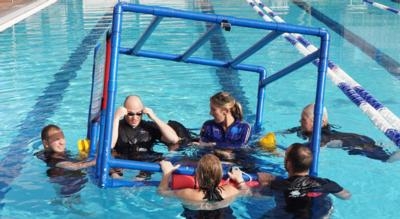Mon, Jan 23, 2017
Practice Sessions Held In Three Locations Around The Country
AeroCare Air Ambulance recently held their annual "Safety Days" training in all three base locations: Scottsdale, Chicago, and Ft. Lauderdale. Medical and flight crews, as well as members of the sales team and communication center, participated in the training which simulated an aircraft ditching in water.

The simulation was accomplished by using a specially built-training prop (simulator) made to resemble the the interior of a Learjet. The simulator was built to the specifications of one of AeroCare's existing Learjet air ambulances, right down to the exact measurements, seats, and safety belts. Crew also were provided with the standard aviation life jackets.
The simulation took place in a swimming pool at each location. Some of the crew and employees were a little apprehensive about being strapped in and flipped under water. AeroCare Aeromedical Case Manager Jennifer Elaqad, who participated, said, "It was a scary experience. I have a new-found respect for our medical crews and pilots."
AeroCare's Corporate Clinical Educator, Dave DiClementi, said, "The simulator was flipped upside down with the crew members inside. They had to maintain situational awareness and escape from the simulator through the emergency exit. Once outside of the simulator, their life jacket had to be properly worn and inflated. They then had to regroup and show proper techniques to conserve energy and maintain body temperature as a team. This training uses crew resource management during aircraft emergencies"
At AeroCare, safety is the number one priority. DiClementi said, "This training is a small part of the training exercises that we do at AeroCare regarding safety. Safety training is important to inform our crews of the inherent risk of this type of work and to ensure their success if faced with a survival situation. The more prepared our crews are in safety and survival, the more successful they will be for themselves as well as for our customers. Crew members have a better understanding of their own limitations and fears. From a management perspective we gain an understanding of weaknesses which can help us better staff our flights so that our crew members can complement weakness with strengths."
(Image provided with AeroCare news release)
More News
Aero Linx: American Aviation Historical Society AAHS is dedicated to the preservation and dissemination of the rich heritage of American aviation. Our purpose is to collect, preser>[...]
CrewMember (UAS) A person assigned to perform an operational duty. A UAS crewmember includes the remote pilot in command, the person manipulating the controls, and visual observers>[...]
Immediately After The Right Main Tire Contacted The Runway Surface, The Right Main Landing Gear Failed On October 31, 2025, at about 1227 Pacific daylight time, a Maule M-7-235A, N>[...]
Also: IAE Acquires Diamond Trainers, Army Drones, FedEx Pilots Warning, DA62 MPP To Dresden Tech Uni The danger to the flight training industry and our future pilots is clear. Dona>[...]
"On December 3, 2025, at approximately 10:45 a.m., a Thunderbird pilot ejected safely from a F-16C Fighting Falcon aircraft during a training mission over controlled airspace in Ca>[...]
 ANN's Daily Aero-Linx (12.03.25)
ANN's Daily Aero-Linx (12.03.25) ANN's Daily Aero-Term (12.03.25): CrewMember (UAS)
ANN's Daily Aero-Term (12.03.25): CrewMember (UAS) NTSB Prelim: Maule M-7-235A
NTSB Prelim: Maule M-7-235A Airborne-Flight Training 12.04.25: Ldg Fee Danger, Av Mental Health, PC-7 MKX
Airborne-Flight Training 12.04.25: Ldg Fee Danger, Av Mental Health, PC-7 MKX Aero-News: Quote of the Day (12.04.25)
Aero-News: Quote of the Day (12.04.25)



